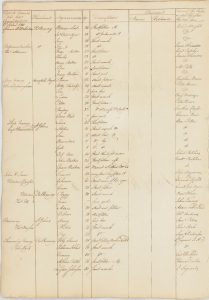Click here to download all the pages of Inspection Roll of Negroes Book No. 2.
Click here for a full transcription of the document.
Background
Beginning in 1775, the British military offered freedom to any enslaved person owned by a Patriot who ran away and assisted the British war effort. They hoped that robbing the Patriots of their enslaved workforce would weaken communities and bring the war to a faster end.
Historians estimate that around 20,000 enslaved people took the opportunity to self-emancipate between 1775 and 1783. Many were women with children or whole families escaping together. There was no plan for the people who responded to the call. Some men were formed into fighting regiments. Some women were hired as washerwomen and cooks. Many were held as low paid or unpaid servants of the Army officers and staff. Life was incredibly difficult for those who self-emancipated during the war. Before the fighting ended, about 8,000 died of disease or starvation, or in battle.
The Revolutionary leaders demanded that all runaways be returned at the end of the war, and included this demand in the Treaty of Paris. But the British honored their promise to the freed people instead. By the time the final British forces left the colonies in November 1783, between 8,000 to 10,000 emancipated Black colonials had been evacuated from New York and Charleston on ships heading to Nova Scotia, East Florida, the Caribbean, and other parts of the British Empire. Life in these new places would prove to be difficult and dangerous, but every Black person who made this journey was officially free.
About the Document
The British evacuation of New York City began in August 1783 and ended on November 25. British military officers reviewed the cases of thousands of self-emancipated Blacks who wanted to evacuate with the military, and made decisions about who could go and who must stay. They recorded information about those approved for the journey in books that are collectively known as the Book of Negroes, to make sure the private ships helping with the evacuation did not illegal sell their passengers back into slavery in the Caribbean.
The records indicate that 2,744 free Black people evacuated with the British Army and Navy. This is the official number of Black evacuees from New York, though American slaveholders complained that the number was much higher, because the ledgers did not list people who left on private ships. The books include details about what each person looked like (the notes “M” and “B” stand for mulatto and Black), where each person was from, and how they came to be free. This allows historians to reconstruct what that person’s experience of the war may have been. And the notes on past ownership gives us a sense of the ways people ran away in groups and with families, supporting each other in their quest for freedom.
An entire searchable database of the Canadian copy of the Book of Negroes is available online from the Library and Archives of Canada.
Vocabulary
- emancipate: To set free.
- Treaty of Paris: The official peace treaty between the United States of America and Great Britain that ended the American Revolutionary War. It was signed on September 4, 1783.
Discussion Questions
- What does this document reveal about the end of the American Revolution?
- Who could benefit from the British policy of self-emancipation? Who could not?
- Why is it significant that so many of the people listed in this book are women and children?
- What can we infer about the experiences of enslaved people during the American Revolution from this document?
Suggested Activities
- For more information about self-emancipation before the American Revolution, see Runaway Slaves and Conditional Manumission Laws.
- Do a statistical analysis of this section of the Book of Negroes to answer the following questions: What percentage of the evacuees were men and what percentage were women? What percentage were children? Which colonies did the evacuees come from? Where did the evacuees go?
- Ask students to pick a person from the ledger and conduct research to reconstruct that person’s life during the war using the details available. Research the name of the person who owned them, where they ran away from, what parts of the colonies they lived in, and what parts of the war directly affected them.
- Combine this document with the life stories of Deborah Squash and Peggy Gwynn for a lesson on how escaped enslaved women were treated by the British and the Americans during the war.
- Teach this document together with any of the following for a lesson on the ways enslaved women exploited the American Revolution to push for manumission and the abolition of slavery: Life Story: Elizabeth Freeman, Life Story: Peggy Gwynn, Abolition and Revolution: The Poetry of Phillis Wheatley, and Life Story: Deborah Squash.
Themes
POWER AND POLITICS; IMMIGRATION, MIGRATION, AND SETTLEMENT
New-York Historical Society Curriculum Library Connections
- For resources relating to the American Revolution in New York, see The Battle of Brooklyn.







